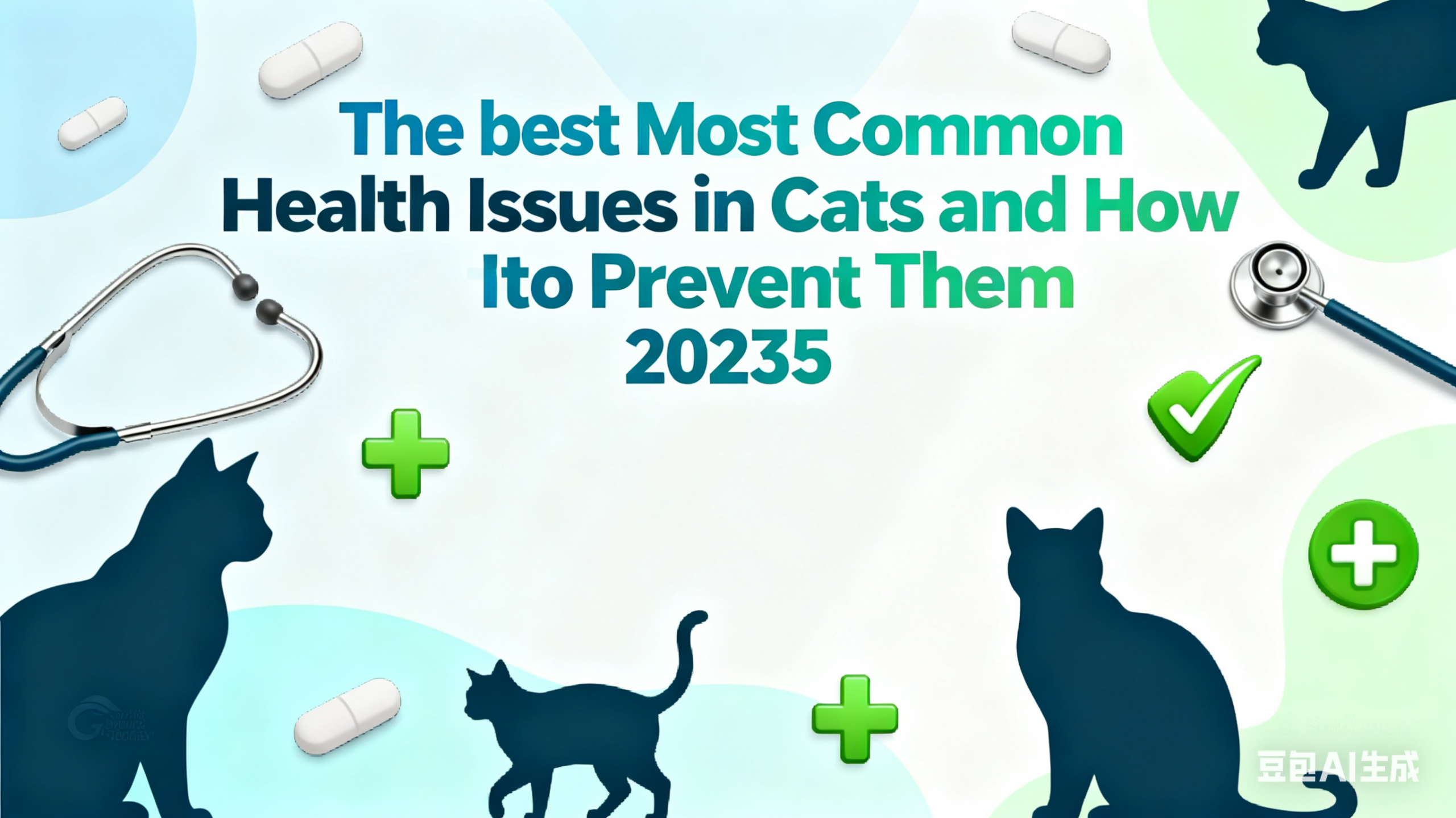The Most Common Health Issues in Cats 2025: How to Prevent Them & Spot Early Signs

Table of Contents
- Introduction: Why Cat Health Awareness Matters in 2025
- 1. Dental Disease: The #1 Common Cat Health Issue
- 2. Obesity: A Silent Threat to Cat Health
- 3. Urinary Tract Infections (UTIs) & FLUTD
- 4. Parasites: Fleas, Ticks & Worms
- 5. Respiratory Infections: Viral & Bacterial Risks
- 6. Kidney Disease: A Top Concern for Senior Cats
- Key: Early Signs of Cat Health Issues to Watch For
- 2025 Cat Health Prevention Checklist
- Conclusion: Keeping Your Cat Healthy in 2025
Introduction: Why Cat Health Awareness Matters in 2025
Cats are masters at hiding pain—so by the time you notice obvious symptoms, a health issue may already be advanced. That’s why understanding the most common health issues in cats 2025 is non-negotiable for pet owners. From preventable problems like dental disease to age-related risks like kidney disease, these issues affect millions of cats yearly—but with the right steps, you can reduce their risk, spot signs early, and keep your feline companion thriving.
In 2025, vet data shows three trends: dental issues are still the top concern, obesity rates are rising (thanks to indoor lifestyles), and urinary problems (like FLUTD) are increasingly common in male cats. This guide breaks down each issue, how to prevent it, and what early warning signs to never ignore.
1. Dental Disease: The #1 Common Cat Health Issue
Vets agree: dental disease is the most common health issue in cats 2025—affecting up to 70% of cats over 3 years old. It starts with plaque (bacteria on teeth) that hardens into tartar, leading to gum inflammation (gingivitis), tooth decay, and even tooth loss. Left untreated, bacteria can enter the bloodstream and damage organs like the heart or kidneys.
How to Prevent It
- Brush their teeth: Use a cat-specific toothbrush and toothpaste (never human toothpaste— it’s toxic!). Start slow (10 seconds a day) to get your cat used to it.
- Dental chews/toys: Look for VOHC (Veterinary Oral Health Council)-approved chews (like Greenies) that scrape tartar. Rubber toys (e.g., Kong) also help clean teeth during play.
- Annual vet cleanings: Professional cleanings (under anesthesia) remove tartar below the gums—critical for cats that resist brushing.
Early Signs to Spot
Bad breath, red/swollen gums, yellow tartar on teeth, or your cat avoiding hard food (they’re in pain when chewing).
2. Obesity: A Silent Threat to Cat Health
2025 data from the American Association of Feline Practitioners (AAFP) (a DoFollow link) shows 60% of cats are overweight or obese—making it the second most common health issue in cats. Extra weight leads to diabetes (obese cats are 4x more likely to get it), joint pain (arthritis), heart disease, and shorter lifespans (obese cats live 2-3 years less on average).
How to Prevent It
- Feed a balanced diet: Choose high-protein, low-carb cat food (avoid “grain-free” brands with excessive carbs). Follow portion sizes—use a measuring cup, not guesswork.
- Add daily exercise: Play with your cat for 15-20 minutes twice a day. Use feather wands, laser pointers, or treat-dispensing toys to get them moving (indoor cats need extra activity!).
- Skip table scraps: Human food (like cheese or chicken skin) is high in fat and calories—even small bites add up.
Early Signs to Spot
A “round” belly (no visible waist when viewed from above), difficulty jumping onto furniture, or lethargy (they sleep more and play less).
3. Urinary Tract Infections (UTIs) & FLUTD
Urinary issues—including UTIs and Feline Lower Urinary Tract Disease (FLUTD)—are among the most common health issues in cats 2025, especially in male cats (their narrow urethras are prone to blockages). UTIs are caused by bacteria, while FLUTD is a broader term for issues like bladder inflammation, crystals, or blockages (life-threatening if untreated).
How to Prevent Them
- Fresh water always: Cats avoid stale water—change bowls twice a day, or use a cat water fountain (they drink 3x more from fountains!).
- Clean litter boxes: Scoop daily and change litter weekly. Cats hate dirty boxes—stress from avoiding them worsens urinary issues.
- Urinary-friendly food: For cats at risk (e.g., history of crystals), vet-recommended diets (like Hill’s c/d) reduce crystal formation.
Early Signs to Spot
Straining to urinate (they’ll squat for minutes), frequent small trips to the litter box, blood in urine, or urinating outside the box (a cry for help—they’re in pain!).
4. Parasites: Fleas, Ticks & Worms
Parasites are a year-round threat and remain one of the most common health issues in cats 2025. Fleas cause skin irritation (scratching leads to hair loss and infections), ticks spread diseases (like Lyme disease), and internal worms (roundworms, tapeworms) cause anemia, weight loss, and even death in kittens.
How to Prevent Them
- Monthly preventatives: Use vet-approved flea/tick meds (topicals like Frontline or oral meds like Bravecto)—never use dog products (they’re toxic to cats!).
- Deworm regularly: Kittens need deworming every 2 weeks until 12 weeks; adult cats need it 2-4 times a year (even indoor cats—worms can come via mice or contaminated soil).
- Indoor safety: Keep cats indoors to avoid ticks and flea-infested animals. Vacuum floors/couches weekly to remove flea eggs.
Early Signs to Spot
Scratching/biting at skin, tiny black “flea dirt” on fur (looks like pepper), visible ticks on ears/neck, or worm segments in stool (white, rice-like bits).
5. Respiratory Infections: Viral & Bacterial Risks
Respiratory infections (caused by feline herpesvirus, calicivirus, or bacteria like chlamydia) are common in cats—especially kittens and shelter cats. They spread via sneezing, sharing food bowls, or close contact, and can lead to pneumonia if untreated.
How to Prevent Them
- Vaccinations: Kittens get a series of “distemper” shots (which include respiratory virus protection); adult cats need booster shots yearly.
- Isolate sick cats: If your cat sneezes/coughs, keep them away from other cats to stop spread.
- Clean environment: Disinfect food bowls, litter boxes, and toys with a cat-safe cleaner (like vinegar and water) to kill viruses.
Early Signs to Spot
Sneezing, runny nose/eyes (clear or yellow discharge), coughing, or loss of appetite (they feel too sick to eat).
6. Kidney Disease: A Top Concern for Senior Cats
Chronic kidney disease (CKD) affects 1 in 3 senior cats (over 10 years old) and is a leading common health issue in cats 2025. Kidneys filter waste, so CKD leads to toxin buildup, weight loss, and dehydration. It’s progressive, but early treatment slows decline.
How to Prevent It
- Annual vet checkups: Blood work detects early kidney issues (before symptoms show). Senior cats need bi-annual checks.
- Hydration: Encourage water intake (fountains, multiple bowls) to reduce kidney strain.
- Kidney-friendly diet: For early CKD, vet diets (like Royal Canin Renal Support) lower protein and phosphorus to ease kidney work.
Early Signs to Spot
Increased thirst/urination (they drink more and use the litter box often), weight loss, vomiting, or bad breath (toxin buildup causes a “uremic” smell).
Key: Early Signs of Cat Health Issues to Watch For
Cats hide pain, so knowing these red flags can save their life—they’re common across the most common health issues in cats 2025:
– Changes in appetite (eating less/more than usual)
– Lethargy (sleeping all day, no interest in play)
– Changes in litter box habits (urinating outside, straining, or no stool for 2+ days)
– Weight loss (even 1 pound in a 10-pound cat is a warning)
– Skin/coat issues (dull fur, hair loss, or redness)
If you notice any of these, schedule a vet visit within 24-48 hours—early intervention is key.
2025 Cat Health Prevention Checklist
To tackle the most common health issues in cats 2025, use this monthly/yearly checklist:
| Frequency | Task |
|---|---|
| Daily | Refresh water, scoop litter box, play 15+ minutes |
| Weekly | Brush teeth 2-3x, vacuum for fleas, check for ticks (if outdoor) |
| Monthly | Give flea/tick preventative, weigh your cat (track changes) |
| Yearly | Vet checkup (dental exam + blood work); senior cats: bi-annual checkups |
Conclusion: Keeping Your Cat Healthy in 2025
The most common health issues in cats 2025—dental disease, obesity, urinary problems, parasites, respiratory infections, and kidney disease—are all manageable with prevention and early action. By brushing their teeth, feeding a balanced diet, keeping up with vet visits, and watching for red flags, you can help your cat avoid pain and live a long, happy life (indoor cats often live 12-18 years with good care!).
Remember: your vet is your partner. If you’re unsure about your cat’s health—even small changes—don’t wait to ask. A quick checkup can turn a minor issue into a preventable one, letting you enjoy more years with your furry companion.
To find a vet who specializes in cat health (critical for addressing these common issues), check out our guide: How to Choose a Vet for Your Pet — it breaks down what to look for in a cat-friendly vet.




Leave a Comment